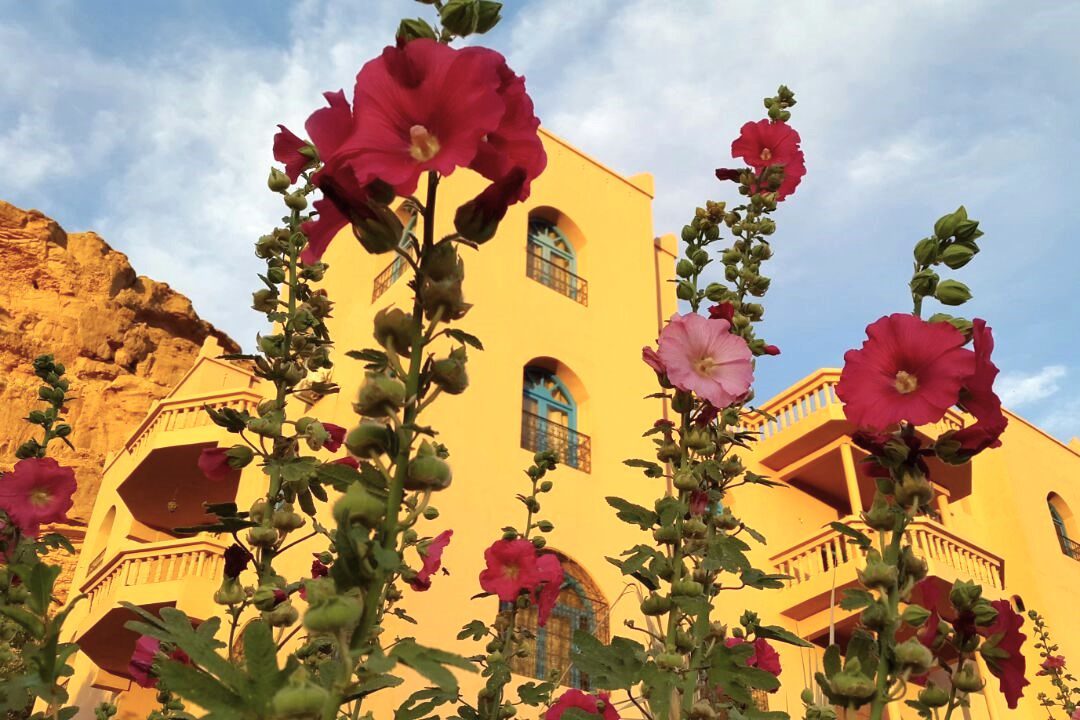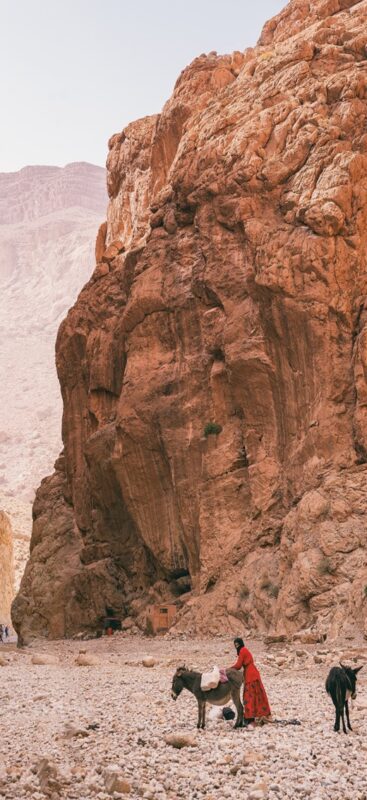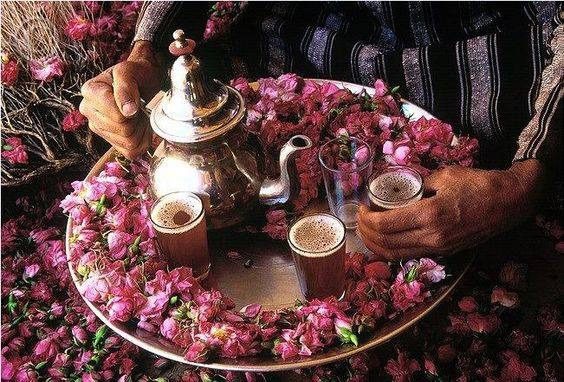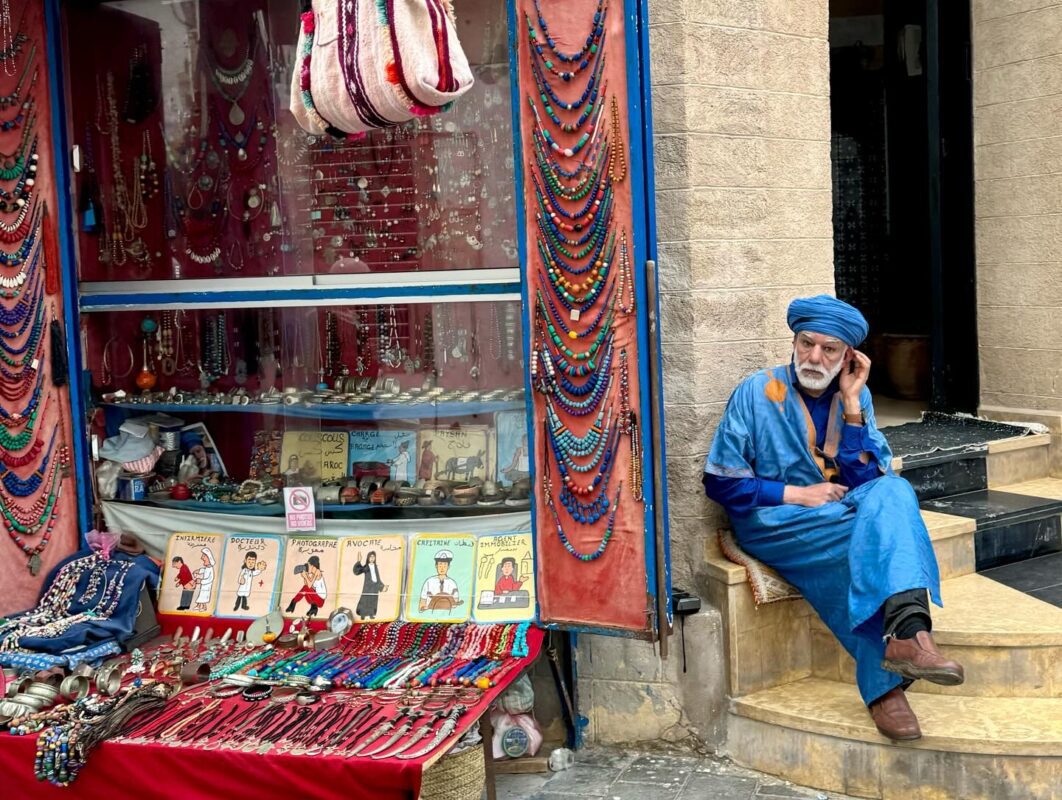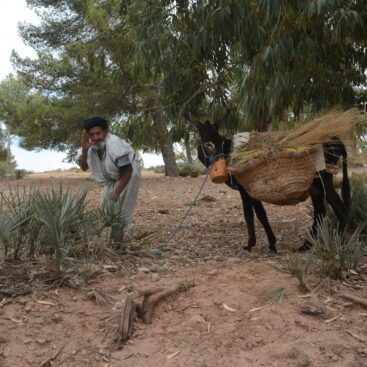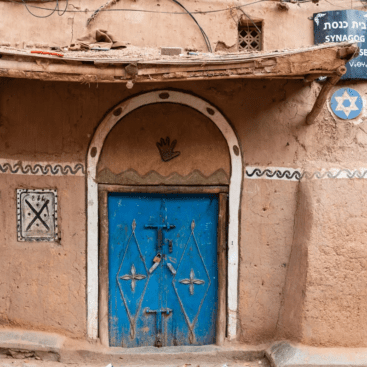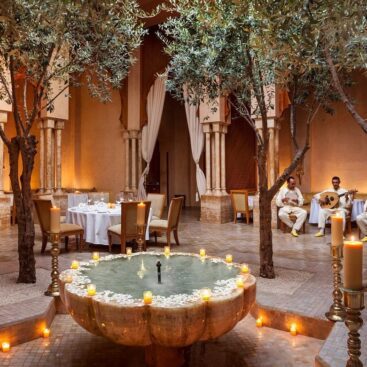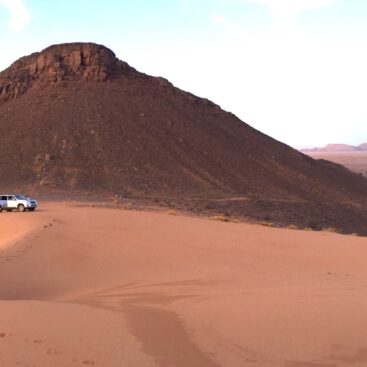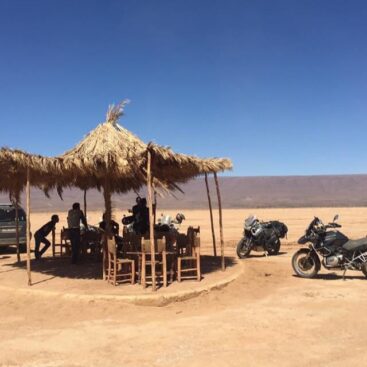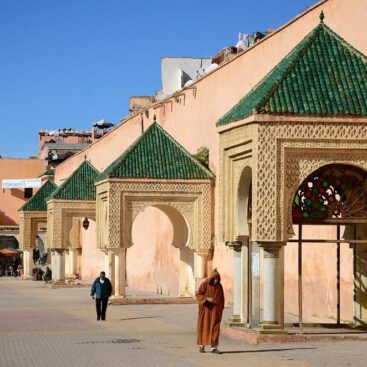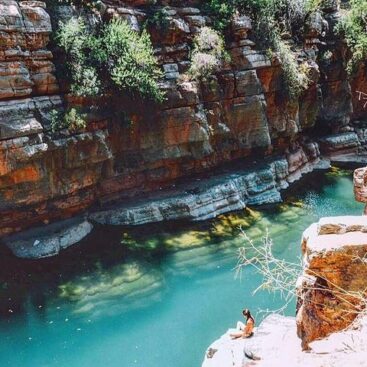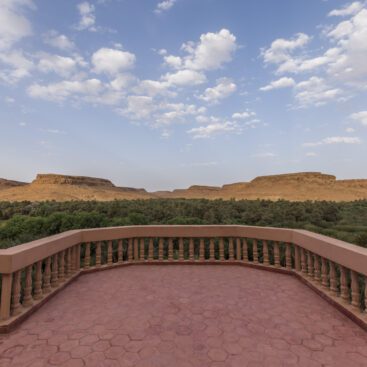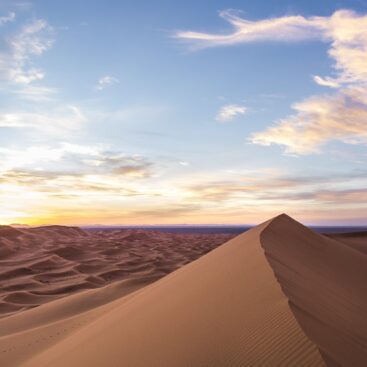This slow tour is ideal for those who want to explore Morocco without having to travel long distances by car. The itinerary is designed to allow for a complete immersion in a relaxed way, with extra time in the most important imperial cities: Fez and Marrakesh.
The first night in Casablanca also allows you to rest and recharge for the next days.
We suggest spending a night in Midelt, to avoid the long 8-hour drive from Fez to the Merzouga Desert, dividing it into two days. The hotel we suggest in Midelt is built in a chalet style and is located in a peaceful area with thermal waters, overlooking a large lake.
To customize your trip, contact us for more information!
Highlight of the day: Hassan II mosque
Arrival at Casablanca airport where our guide will be waiting for you punctually and properly identified.
A highlight is the Hassan II mosque built over the sea and one of the few in the world that non-Muslims can visit. The mosque is monumental (it is the tallest in the world outside of Mecca) and there are guided tours that will show you in detail one of Morocco’s most emblematic heritage sites.
If you want to eat good fresh fish, you can find several restaurants along the Corniche, a beautiful avenue lined with palm trees facing the sea.
Points of interest:
Sacred Heart Cathedral, one of the largest Catholic churches in Morocco. It is built in art deco style and is 33 metres high. It is currently temporarily closed for construction, but it is definitely worth going to see this monumental building from the outside.
The Moroccan Jewish Museum is a museum dedicated to Jewish life in the Arab world. The current building originated from a Jewish orphanage founded in 1948.
For dinner, we recommend the famous “Rick’s Café” , a charming and iconic place that was built to recreate the film “Casablanca”. Here, you will enjoy live traditional Arabic music while you dine in this wonderful Riad. The food is a well-conceived mix of European and Moroccan cuisine.
Highlight of the day: Imperial city of Rabat
We continue to Rabat, where you will have the opportunity to enjoy its beautiful domes, minarets, wide avenues and green spaces.
Rabat is a city that grew up in the 14th and 15th centuries, with the expulsion of Andalusians from the Iberian Peninsula. It is surrounded by three walls corresponding to the most remarkable phases of its history: the Almohad Wall, the Andalusian Wall and the Alawite Wall. Your guide will show you walls and the main points of the city, such as the Hassan Tower, situated on top of an imposing mosque, the opulent tomb of Mohammed V, decorated with stained glass, white marble and a wrought iron entrance with a staircase leading to an impressive dome.
Walk through the Kasbah das Oudayas, an ancient military fortification built in the 12th century, overlooking the Atlantic Ocean. The history of the place is visible through the monuments that make up the Kasbah as: its famous monumental door (bab el-Kébir, one of the emblems of Almohad architecture); the royal residence of the Alaouite dynasty (still reigning); the Jamaa el Atiq mosque; the princely house erected to the west; the military structure of Borj Sqala.
Visit also the Mohammed VI Museum of Contemporary Art, which has works by Moroccan and international artists, an excellent museum on a par with the famous museums in Paris.
Highlight of the day: Imperial city of Meknes
Embark on a captivating journey to Fes, stopping along the way to marvel at the imperial city of Meknes, a beautifully preserved example of a large Roman colonial city.
Meknes, under the visionary Sultan Moulay Ismail, aspired to become the crown jewel of North Africa, emulating the grandeur of Versailles and fostering diplomatic ties with Louis XIV of France. This ambitious sultan even sought a marriage alliance with the French royal family, earning Meknes the nickname “Maghreb Versailles.”
Nestled in the Meknes region, the city boasts a thriving wine industry, leveraging highly esteemed French grape varieties. Meknes is also rich in Jewish history, hosting several synagogues, including the El Krief, a community center, and the renovated Jewish Cemetery in Mellah de Meknes. The presence of Hebrew epitaphs from the Christian era, alongside Greek inscriptions, underscores the city’s cultural diversity and is further evidenced in the Jewish zaouia, a pilgrimage site where Rabbi David Benmidan still resides.
Exploring Meknes’ streets, you’ll notice that many are named in honor of Jewish rabbis and other prominent figures who once called this city home. While eleven synagogues remain, none are actively used today, serving as poignant reminders of Meknes’ past.
You can visit a winery and spend some delicious moments tasting the wine accompanied by an excellent lunch or just a snack, in one of the most charming wineries that is also a luxury hotel with French and Moroccan inspiration.
As the afternoon draws to a close, arrive in Fes, a city that shines in the soft light of the setting sun. Enjoy a panoramic tour of Fes, immersing yourself in its breathtaking beauty and historic charm.
Highlight of the day: Discover the ancient city of Fes
Paul Bowles described Fes as an “enchanted labyrinth sheltered from time”. This is why this day is dedicated to visiting this mysterious city. Visit Fes with the support of a guide dedicated solely to this city, so that you can get to know it in depth: its nooks, crannies, traditions, stories and histories.
Fes was once the capital of Morocco, and has Fatimid, Andalusian, Arab, Berber and even Jewish influences. The city reached its peak in the 13th century, where it became a hub of knowledge, with one of the oldest universities in the world, the Al Quaraouiyine University, which is capable of issuing diplomas, according to UNESCO.
The Madrassa Bou Inania, an ancient Islamic school, stands out as an architectural masterpiece, displaying details in ceramics, stucco and carved wood. This is just one example of the rich architectural heritage that Fes has, reflecting the legacy of the dynasties that ruled the region over the years.
Local craftsmanship is a vital part of Fes’ identity. Tanners, for example, continue to work in the same way as their ancestors, using traditional methods to transform hides into high-quality products. A visit to the Chouara Tannery is a unique sensory experience, where visitors can witness the artisanal process and also appreciate the variety of products produced there: bags, coats, carpets, shoes, etc.
Fes ceramics are an artistic expression that reflects the city’s rich artisanal tradition, and are an essential part of Moroccan cultural heritage. The centers of ceramic production in Fes are often found in the Medina, where artisans work in family workshops.
The products range from tiles and mosaics to plates, vases, bowls, cups and other decorative items. The colors used reflect the traditional Moroccan palette, with bright hues such as blue, green, yellow and terracotta. The pieces often incorporate intricate geometric patterns or elements inspired by nature and Islamic culture.
Highlight of the day: Cedar forests, Ifrane
We embark on our journey in the morning, bound for the enchanting cedar forests where nature’s splendor will captivate your senses. The serene atmosphere, crisp air, and the alluring scents of the wilderness create a tranquil escape.
Next, we journey to Ifrane, affectionately known as “Moroccan Switzerland,” a breathtaking locale that invites contemplation amidst its lush mountain vistas. Winter brings a blanket of snow, transforming the landscape into a winter wonderland. Along the way, keep your eyes peeled for monkeys and other wildlife native to these cedar forests, adding an extra layer of excitement to your adventure.
As the day draws to a close, we arrive in Midelt, where we retire to a cozy hotel overlooking a serene lake, embraced by the purity of nature. This idyllic setting promises a restful night, setting the stage for more unforgettable experiences to come.
Highlight of the day: Sahara Desert, desert village, desert town, camel ride, luxury camping
Start the day on your way to the deepest desert. The journey is made smoothly through slopes and dunes that our guide knows like the back of his hands.
On the way to the Merzouga Desert, we will pass through Erfoud. Near Erfoud, there are fossil excavations where today you can find several fossils of trilobites and other primitive species. This allows us to conclude that the soil of the Sahara Desert was, in ancient times, the bottom of an ocean. Here you can also buy original fossils at very low prices.
We continue to Rissani, which is the capital of the historic Tafilet region. In the past it was an important trading post, as it was on the route of the Saharan camel caravans. Gold, spices, fabrics and… weapons and slaves were traded there. It has a market and a souk that is very interesting to visit, it is like entering an epic film of the Middle Ages, a very authentic place with amazing products, donkey market included!
Perform various activities in the desert, which can be of the most varied type: quad rides, Moroccan cuisine workshops or even contact nomads, embracing their music and traditions.
In the late afternoon, set off on a camel ride (or in one of our 4×4 vehicles) through the Erg Chebbi dunes for about an hour until you reach the Berber tent where you will spend the night. The colours of the dunes at dusk are a delight for those who enjoy photography.
Dinner will be served there and then there will be live traditional music around a campfire. This music, based on drums and guitars, is captivating and irresistible. Then comes the impressive and magical absolute silence of the desert, inviting you to go inward. The sky is clear and full of stars. This will undoubtedly be an unforgettable experience.
Highlight of the day: Todra gorges, Dades valley
After savoring a delicious breakfast and witnessing the breathtaking sunrise over the dunes, we embark on a journey to the captivating Dades valley.
Our first stop is the awe-inspiring Todra Gorges, where towering cliffs soar to a height of 300 meters, separated by a mere 15 meters of breathtaking beauty. Here, we take a leisurely stroll along the river, immersing ourselves in the grandeur of this unique rocky terrain, where every turn reveals a new marvel of nature.
Next, we go to the stunning Dades Valley, a place of unparalleled natural beauty and geological fascination. This valley is a diverse landscape, with arid mountainscapes reminiscent of the desert, fertile valleys where the sounds and scents of nature are ever-present, and snow-capped peaks in the winter months. Scattered throughout the valley are typical Kasbahs, ancient walled villages that offer a glimpse into Morocco’s rich history and culture. Additionally, we marvel at Jbel Saghro, a mountain that stands apart from the rest, its arid landscape akin to the surface of the Moon, adding an otherworldly touch to our adventure.
The day ends in a charming hotel with a superb view over the Dades Valley.
Highlight of the day: Ouarzazate, High Atlas mountains, Kasbahs
Continuing along the enchanting “Route of the Thousand Kasbahs,” we make our way to Kalaat Mgouna, the City of Roses, where the air is fragrant with the sweet scent of blooms. Our journey also includes a visit to the oasis of Skoura, a serene oasis dotted with ancient Kasbahs, each one a masterpiece of Moroccan architecture, surrounded by lush palm forests that provide a cool oasis in the heart of the desert. This journey promises to be a memorable experience, filled with breathtaking scenery and rich cultural insights.
Ouarzazate is known as the “Desert Gates” city for its location between the Atlas Mountains and the Sahara Desert. In addition to the scenery, here you can visit the Kasbah Taouirt of the old fortress, the palace of Pasha Glaoui near the Medina and the famous film studios that have shot several historical films, including the famous Lawrence of Arabia.
We will continue our journey and stop at Ait Benhaddou, the most important site on the route of the ‘Thousand Kasbahs’, classified as a UNESCO World Heritage Site. He is famous for having served as the setting in many Hollywood films, such as “The Mummy”, “The Gladiator” and “The Game of Thrones”.
On the way to Marrakech, we will make several stops: we will be able to visit the craft cooperatives and see how the famous Moroccan carpets are still handmade, how argan oil is produced, etc.
We will finally arrive in Marrakech where there are surprises around every corner, from artists playing original or traditional instruments, all kinds of products and shows, modest gardens and colorful and aromatic markets.
Highlight of the day: Explore the red city of Marrakech
Explore Marrakesh, Morocco’s red city and the country’s cosmopolitan hub. The intense aroma of spices, the colourful and exotic atmosphere, the hidden corners and secrets of its history and its surprising architecture make this city the most attractive and visited in Morocco.
During the day, be accompanied by a guide dedicated exclusively to the city of Marrakesh, so that you can enjoy the best this city has to offer, explore its history and the atmosphere of fantasy and surprise that Marrakesh always has.
There are several monuments to visit, among which the following stand out:
Madrassa Ben Youssef: This 12th-century Islamic college in Marrakesh was built by the Sultan Ali ibn Yusuf of Morocco. Today it is a museum that can be visited. The interiors are wonderful, all decorated and its architecture is amazing.
Koutoubia Mosque: Without a doubt the most famous and most photographed monument in Marrakesh. The Koutoubia Mosque was built in the 12th century and was the model for the Giralda in Seville and the Hassan Tower in Rabat.
Bahia Palace: This beautiful 19th century palace was extravagantly built to be the finest in Marrakech. This palace has a huge garden, a central courtyard and several rooms incredibly decorated with the work of artisans who came specifically from the city of Fez to work.
Saadian Tombs: These 16th century tombs were built by Ahmad al-Mansur and contain the remains of around 60 members of the original Saadian Dynasty from the Draa River valley in the south of the country. Interestingly, the tombs were only discovered in 1917. These tombs are one of the most visited monuments in Marrakech.
In the afternoon visit outside Medina:
Majorelle Gardens: This is the only botanical garden in Marrakech. It was designed by the artist Jacques Majorelle and has belonged to Yves Saint-Laurent and Pierre Bergé since 1980. You can enjoy a wonderful garden with exotic flowers from all over the world. The tickets need to be bought here in advance: https://www.jardinmajorelle.com/en/
The Yves Saint Laurent Museum: It has a permanent exhibition as well as temporary exhibitions, with masterpieces by this famous creator. The building itself has a charming modern architecture with traditional touches.
- Private transport throughout the trip in 4×4 car, new and safe, with air conditioning. All our cars have tourist license from the Government of Morocco and insurance for our customers;
- Permanent guide that speaks Spanish, English French and Portuguese;
- Accommodation throughout the trip, with breakfasts;
- Dinners in Dades valley, Midelt, Merzouga;
- Additional official guide in the Medinas of Meknes, Marrakech and Fes;
- 1 night in Berber camp in a luxury nomad tent;
- Camel ride with a view to reaching the camp.
● Entrance fees.
Highlights of the Tour
- High and Middle Atlas Mountains;
- Imperial cities of Marrakesh, Meknes and Fes;
- Merzouga Desert;
- Hassan II Mosque;
- Fes’ Ceramics;
Activities to choose
- Cooking workshop in Merzouga;
- Quad ride in the dunes;
- Other activities

